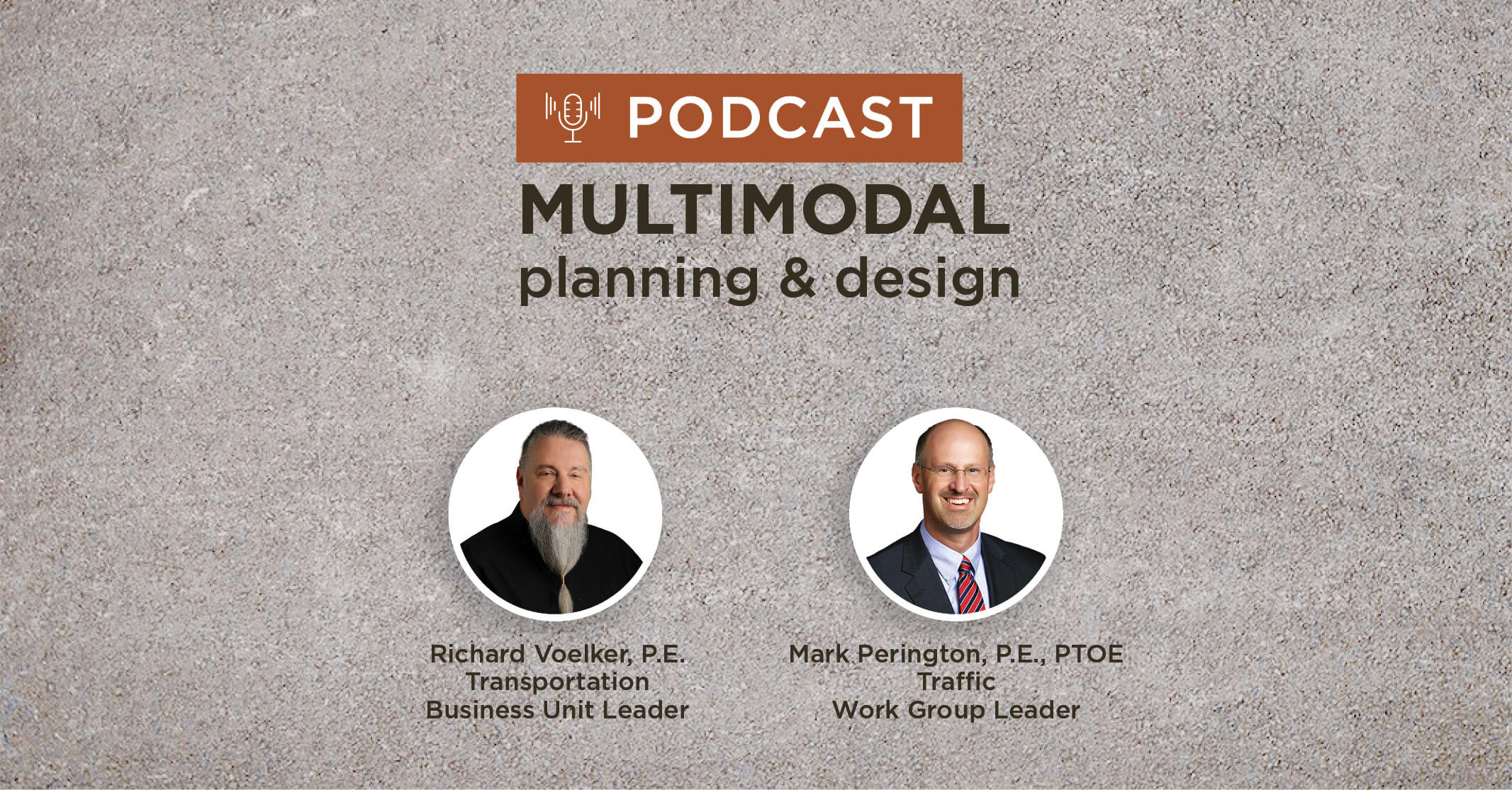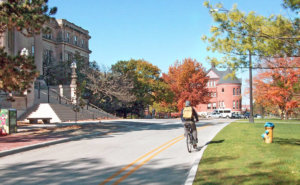Considerations and Objectives for a Safe Multimodal Transportation System
Beginning in the 1940s, rapid suburban growth led to sprawling communities that made households overly dependent on automobiles. As a result, many communities created well-developed road networks but with minimal accommodations for non-automobile travelers. As preferences shifted over the intervening years toward more healthy and eco-friendly modes of travel, the Snyder & Associates team has helped lead the way in this transition. Today, our designers consider all factors when designing transportation networks, including walking, bicycling, and public transit — and the critical connections that tie them together.
Multimodal safety is now a chief consideration of planning efforts as communities encourage recreation and active transportation by adding sidepaths, bike lanes, and trails. These amenities benefit communities by increasing connectivity between neighborhoods, businesses, and parks. However, they also create conflict points at intersections that must be addressed during design. In this podcast, our transportation experts, Rich Voelker, P.E., and Mark Perington, P.E., PTOE, discuss the critical components of multimodal transportation planning, including “complete streets,” ADA compliance, and user comfort.
Podcast Agenda
- Multimodal Planning by Corridor Classifications (0:19)
- Elements of Complete Streets (1:34)
- Evolution of Bike Accommodations on Roadways (3:50)
- Advisory Bike Lanes Used for Rural Roadway Sharing (5:37)
- Bicycle Facility Types & Intersection Treatments (7:34)
- Accommodating Sidepaths at Signalized Intersections (10:34)
- Multimodal Safety Considerations (13:26)

Rich Voelker, P.E.
Transportation Business Unit LeaderRich Voelker, P.E.
Transportation Business Unit LeaderStreet & Highway Design, Intersection Improvements, Trails Design & Planning, Pavement Management

Mark Perington, P.E., PTOE
Traffic Group LeaderMark Perington, P.E., PTOE
Traffic Group LeaderTransportation planning, Traffic studies, Traffic impact studies, Conceptual intersection, Roadway design
Multimodal Planning by Corridor Classifications
Rich Voelker (00:19)
Thank you for joining us today. We’re talking about multimodal safety considerations. Safety is always at the forefront of a lot of the projects that we do. Walk us through some things to consider from a safety perspective when introducing pedestrians and bicyclists into different classifications of the corridor; between local streets, collectors, and arterials. What comes up in your mind as things to consider?
Mark Perington (00:46)
I think it is a challenge for us when we start to talk about a higher classification roadway and an arterial road that may have fewer driveway points and less land use density around it. These are still great corridors for mobility, but you’re right. It’s kind of like both modes get a little separated from each other as you’re in those corridors as you just get farther apart. Then it can become that presence of mind of I’m going along a very busy high-speed road on a sidepath. I’m not thinking about traffic as much because I haven’t had to interfere with it.
However, when we get to those points of conflict intersections that’s what always becomes a challenge. How we must treat that so that we make sure both users start to become aware of each other again, visibility is good, and we minimize the conflict in the features as we put the corridors together.
Elements of Complete Streets
Rich Voelker (01:34)
Describe for me, if you will, what the term complete streets means to you. Whether it’s context-sensitive design or complete streets, once a term like that is thrown out, oftentimes, it’ll mean different things to different people. When it comes to fulfilling the process of development and making sure that it meets a complete streets consideration, what does that mean in the work that you do?
Mark Perington (01:58)
Sometimes you just can’t make it all fit within a certain corridor. It is important that we start from that point of all modes, but quite often it’s recognizing when it is okay to say we just can’t fit that in. It’s important we start from that point and ask the question of how do we do it. It’s having a recognition that sometimes we just can’t accommodate everybody.
We make sure to try to look at it in a bigger system approach, rather than just this street, this highway. I think that’s the key to it is that we always start and ask ourselves, are we trying to accommodate all modes as best we can in a complete system? Then from there, work on what can we get done.
Again, we go back to the limited resources, the limited budget, or that limited right-of-way problem. Sometimes, we can create a bigger problem when we try to put too much into one corridor. We might be having an unintended consequence of crash potential or safety risk.
Rich Voelker (02:59)
One of the things that I tend to think about is considering the hierarchy of what the corridor is intended to provide. We did one project in a college campus setting and it was very interesting how we turned the normal hierarchy of roadway design completely upside down. Where the most important thing in this corridor is pedestrians, the second most important thing is bicycles, the third most important is transit, and the least important thing is cars. It’s also a good example of a way to describe complete streets. It’s how you make your decisions. You have certain goals for your project. You have constraints to work within. Okay, now what are you going to use for decision-making? What is important that this corridor provides?
Evolution of Bike Accommodations on Roadways
Rich Voelker (03:50)
When we zero in a little bit more on bicycle accommodation, there’s been an evolution of bike accommodation on roadways. Starting with just painting a solid white line, calling it a bike lane, giving them a little bit of room at the gutter line, and calling that bike accommodation. What
we come to find out if there’s a perceived safety as well that lends itself to different types of accommodation. Why don’t you talk a little bit about that?
Mark Perington (04:17)
When we start talking about complete streets multimodal, we are dealing with quite a variety of vehicle shapes. Whether that vehicle is just a person walking or maybe skateboarding, they don’t really have a lot of protection. It’s important that we understand and work with that context. That’s something I think we try very hard to do for the clients we are working with. Again, I think the public’s recognition of something and how they deal with it, as well as the user of some of these facilities. It’s important to us when we bring that all back around to safety. How we do these things or how we think it fits the context of the area fits the context of the users and their understanding.
At times, yes, newer things will catch on, and people will start to behave differently. It is important as we look at things, and keep our eyes and ears open to things we see nationally. I think many would admit if you’re talking about our Midwestern area here, but then say compare it to very bike-rich areas an example like Portland’s very heavy bicycling community, there’s kind of a different recognition and acceptance by vehicles. It’s how we take things like that and make sure if we’re going to try certain things like that, we make them the right fit for the community and areas we’re dealing with here in the Midwest.
Advisory Bike Lanes used for Rural Roadway Sharing
Rich Voelker (05:37)
There’s also the type of bike accommodations that we get into with shared-use lanes. Most recently, we’ve been in the experimental process on the advisory bike lanes. Everybody else, I’d be curious as to when you think that shared use is appropriate. With the shared-use marking, there’s a little more flexibility. When you talk about the courtesy of how cars pass the bike on the street and how much room there is, and how much-perceived safety there is, talk a little bit about what some might consider lesser accommodations but can actually be quite functional and safe.
Mark Perington (06:13)
I think some of the shared concepts that we’ve talked about they’re very appropriate, where again, we run into the budget issues that we have. At times we’re dealing with maybe community areas where the reality is it’s an older area. Unfortunately, it may have gone through a time period in which infrastructure wasn’t being installed. There weren’t storm sewers being installed and sidewalks being installed as they built, for example, in a residential building the homes.
The reality for us can be, well, you could try to put in a trail, more bike lanes, or other things like that. Some of that may just require a lot of infrastructure, which in turn costs a lot of dollars. It could be the whole reason that it just doesn’t happen at all. I think our approach in signing and marking, and in this example, it can be an excellent one in that you can still accomplish some goals to provide accommodation. Again, that point alluded to earlier of just kind of the awareness of having those markings and signs out there to say it isn’t going to be this one-off. You might encounter a bicyclist out here. This is a space that is intended to be for pedestrians, bicyclists, and so on as you’re driving your vehicle down the road. It’s that awareness that I’m sharing this corridor with other modes of transportation, and I need to be heads up to it.
Bicycle Facility Types & Intersection Treatments
Rich Voelker (07:34)
Let’s talk a little bit more about streets collectors, arterial, and, up from there, more major corridors that have some level of bike accommodation on them when we come to the intersections. Why don’t you talk a little bit about intersection treatment and how the bikes factor into that from both a control and from a safety perspective? If I’m biking and I’m riding up to a signal, and I see a little marking on the bike lane that says bicycle, like there’s a loop there, is that just making me feel good? Or is there actually something there to detect me?
Mark Perington (08:09)
Bike boxes get you out there where it puts the bicyclist in a greater viewing point for any drivers and vehicles as well as allows bicyclists to get to a point where they can better see and judge what type of vehicle activity is going on, what type of conflict could be approaching.
If we’re talking about bicyclists, most people out there on a bike, even the fearless, even the fearless know if they decide to take the risk and take on a motorized vehicle coming down the road, well, you kind of know the laws of physics, and what’s going to go wrong if that happens. It’s important, even if it is a sidepath on a very busy corridor, we bring them to an intersection. We give them an opportunity to see vehicular traffic that’s out in travel lanes when they make a decision.
Like if they are at a signalized intersection and waiting for that moment, we have things like right turn on red that can lead to conflict. Drivers and cars are negotiating a lot of things as they’re trying to understand when they can do what they want to do to make a certain turning movement. It’s adding another element in there for the bicyclist. Their ability to also see those vehicles clearly and be seen that’s an important thing. It can get a little context things where perhaps with an intersection, beyond some of the specifics they were mentioning, maybe we’re at more of a trail crossing type place that features rectangular, rapid flash and beacons, things like that. That might suggest heads-up to the motorists that bicyclists may be present coming across. But it also is kind of a key opportunity to provide bicyclists a point where they can make sure, okay, can I see everything well so that I can go ahead and make this crossing maneuver? Both people traveling down the road, down a trail, down a path, whatever it may be. They’ve got equal interests in their mind as to where they’re trying to go and how fast they’re trying to get there. They’re just trying to do that safely at the end of the day—a lot of key things for us. When we look at an intersection, we may want to do things with some raised island or other things to separate to provide. Maybe we break crossing up into two or three movements to get a pedestrian or bicyclist across a big busy intersection. Just because you have a large intersection doesn’t mean you can’t get these other modes of travel through that intersection in a safe and efficient manner. Just all that give and take that we have to put into our intersection designs or corridor designs to balance everything out.
Accommodating Sidepaths at Signalized Intersections
Rich Voelker (10:34)
All the Midwestern states have fairly significant trail systems going in, and that’s also a favored bicycle accommodation in metro areas. When you have a trail route, you end up with a sidepath accommodation. Talk a little bit about the challenges that come in when you’re getting to a signalized intersection of accommodating a sidepath safely?
Mark Perington (10:59)
I think the physical nature of how we lay out some of these sidepaths is important. Sometimes we’re very lucky in that we have a large corridor right-of-way because we are dealing with a highway route with higher speed, and we’ve got a lot of room. We tend to locate the sidepath back at the edge of the right-of-way line, which is great. It makes for an enjoyable experience. Speaking as a bicyclist, I enjoy it, you get out there, and you’re able to get moving.
I think what we do, in reference to the comments about when you approach the intersection, is it’s as simple as us just putting a little bit of realignment in that trail to then pull it up tighter into the intersection. Sometimes we see things with sidepaths that get built and you just kind of oh, the sidepath is 25 feet away from the edge of the road and we just keep barreling it all the way through the corridor the same way. It may even just be a smaller, lesser intersection that’s just a stop sign, but you can kind of create this situation where that path if you just let it go parallel and cross it back farther. It may be at a point that puts it in a bit of an awkward situation as to awareness for those approaching the intersection. They see a stop sign ahead, but the trails in advance of it, and so the crossing and so they’re not thinking about it and that can lead to conflict or for the person exiting you’re on a high-speed roadway, and you’ve just finally found a gap and made your left turn. The way you’re looking as you’re driving a vehicle. You’re worried about a different direction than maybe where the bicycle might be coming from. In my example, there is someone turning left, they may be so glad they just finally got a gap and can make their vehicle maneuver then if that trail isn’t a little farther back, not where they’re expecting, or again just that pure what’s in your cone of vision. It’s just not in a location where you may be aware of the bicycle, and it can catch the vehicle off guard. It’s just subtle things like that as we’re designing intersections where the sidepath, that’s the way we can have this big, large corridor that accommodates all these modes, but when we bring it to these intersection points, we’ll guess where we have the conflict. When we start crossing over everybody’s path, it can be little things like that. As simple as, well, let’s put a little curve in that trail, tuck it up closer to the road for that crosswalk, for that cross bike. If we developed something like that again, it gets everything to where it’s in, everybody’s focal point of what they’re looking at in their cone of vision. Little things like that can mean a big difference in what we’re doing.
Multimodal Safety Considerations
Rich Voelker (13:26)
I think we’ve covered quite a bit of ground. I thank you for your input today. Is there a takeaway that you’d like folks to hear about from your perspective when it comes to multimodal safety considerations?
Mark Perington (13:39)
I think looking at everything right up front as best you can on a design project, and again, we take in a lot of information, a lot of data when we’re designing a corridor and intersection. The same thing would apply to the complete streets and the multimodal. We have to take a good look at it and make sure that we’re approaching it from the standpoint of what do we believe if we don’t have the users yet. What will the end-users be? If we do have the users in the corridor, we’re making sure we’re taking a good look at that and how the behavior and how things have been impacted so far.
Again, if we just stick to the kind of standard templates and cookie-cutter, if you will, things aren’t going to be different with it. We have to take a look at that. Just like we may examine, well, how many trucks and how big are the trucks going through an intersection? Are we asking ourselves if this is really a case where we’re dealing with other modes of transportation with pedestrians and bicyclists? Are we approaching it appropriately in the way we’re addressing those? The one thing that I think we talk about with safety, and we’re dealing with cars, trucks, a lot of times we deal with crash frequency. That’s related to some plastic on the road, but unfortunately, given the mix and size of when you go from the non-motorized user up to a vehicle, a truck, or a bus, we know that the conflict typically isn’t going to be good, if there truly is a crash, and so that’s what’s paramount in our minds when we’re talking about safety. You don’t always have the frequency of pedestrian and bicycle crashes, but when you do, unfortunately, the outcomes tend not to be good. That’s what we have to keep in the forefront of our minds when we’re looking at projects and planning efforts for our communities.
Rich Voelker (15:21)
Thanks for all your time today. Thanks to those listening. Be sure to reach out to us if you do have areas of concern or things you want to get going from a planning perspective. It’s a good exercise to go through a detailed planning process to line out how you want your community to function when it comes to the safety of other modes in your transportation system. With that, we’ll wrap this up for today, and safe travels.

